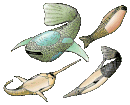Astraspis
| Astraspis Temporal range: middle-late Ordovician
| |
|---|---|

| |
| Fossil specimen of A. desiderata, Field Museum of Natural History | |
| Scientific classification | |
| Domain: | Eukaryota |
| Kingdom: | Animalia |
| Phylum: | Chordata |
| Infraphylum: | Agnatha |
| Class: | †Pteraspidomorphi |
| Subclass: | †Heterostraci |
| Order: | †Pteraspidiformes |
| Genus: | †Astraspis Walcott, 1892[1] |
| Type species | |
| Astraspis desiderata Walcott 1892
| |
| Species | |
| |
Astraspis ('star shield') is an extinct genus of primitive
jawless fish from the Ordovician of Central North America including the Harding Sandstone of Colorado and Bighorn Mountains of Wyoming. It is also known from Bolivia.[2] It is related to other Ordovician fishes, such as the South American Sacabambaspis, and the Australian Arandaspis
.
Description

Nearly complete fossils suggest the living animals were about 200 mm (7.9 in) in length. The body had a mobile
dentine.[3]
It is from these tubercles (which are generally star-shaped) that the name 'Astraspis' (literally "star-shield") is derived.
References
- ^ C. D. Walcott. 1892. Preliminary notes on the discovery of a vertebrate fauna in Silurian (Ordovician) strata. Geological Society of America Bulletin 3:153-172
- ^ Sacabambaspis janvieri. PY Gagnier - Vertébré ordovicien de Bolivie, 1993
- ^ Sansom IJ, Smith MP, Smith MM and Turner P (1997) "Astraspis: The anatomy and histology of an Ordovician fish" Palaeontology, 40 (3): 625–642.
Other sources
Michael J. Benton, Vertebrate Palaeontology, 3rd edition, 2005






